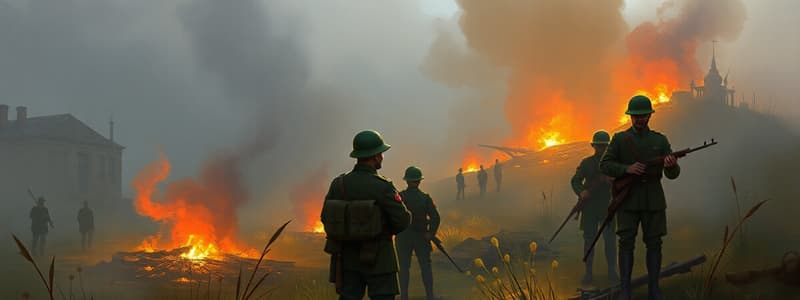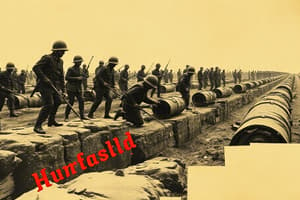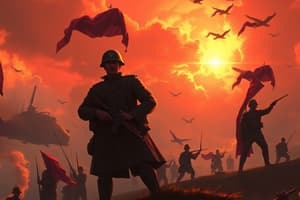Podcast
Questions and Answers
Which military technology contributed most significantly to the static nature of trench warfare on the Western Front?
Which military technology contributed most significantly to the static nature of trench warfare on the Western Front?
- Machine Guns (correct)
- Airplanes
- Poison Gas
- Tanks
What was the primary objective of the League of Nations, as established after World War I?
What was the primary objective of the League of Nations, as established after World War I?
- To redistribute colonial territories among the victorious Allied powers.
- To promote international cooperation and prevent future wars. (correct)
- To enforce the harsh penalties imposed by the Treaty of Versailles on Germany.
- To rebuild the economies of war-torn European nations.
How did the role of women change in many societies as a result of World War I?
How did the role of women change in many societies as a result of World War I?
- Women entered the workforce in greater numbers, contributing to the women's suffrage movement. (correct)
- Women were granted full equality in political and social life immediately after the war.
- Women were restricted to traditional roles in the home to make way for returning soldiers.
- There was no significant change in the social or economic status of women.
Which factor was a primary motivator for unrestricted submarine warfare by Germany during World War I?
Which factor was a primary motivator for unrestricted submarine warfare by Germany during World War I?
Which of the following describes an accurate long-term consequence of the territorial changes and realignments that occurred after World War I?
Which of the following describes an accurate long-term consequence of the territorial changes and realignments that occurred after World War I?
How did the Treaty of Versailles contribute to the rise of extremism and nationalism in Germany in the interwar period?
How did the Treaty of Versailles contribute to the rise of extremism and nationalism in Germany in the interwar period?
What strategic impact did the entry of the United States into World War I have on the conflict?
What strategic impact did the entry of the United States into World War I have on the conflict?
Which of the following best describes the strategic role of airplanes during World War I?
Which of the following best describes the strategic role of airplanes during World War I?
Which of the following scenarios best exemplifies the concept of militarism as a cause of World War I?
Which of the following scenarios best exemplifies the concept of militarism as a cause of World War I?
How did the alliance system contribute to escalating a regional conflict into a global war?
How did the alliance system contribute to escalating a regional conflict into a global war?
How did the Schlieffen Plan impact the early stages of World War I?
How did the Schlieffen Plan impact the early stages of World War I?
What was the primary reason for the United States' entry into World War I in 1917?
What was the primary reason for the United States' entry into World War I in 1917?
What critical impact did Russia's withdrawal have on the course of World War I?
What critical impact did Russia's withdrawal have on the course of World War I?
How did the nature of combat on the Western Front differ from that on the Eastern Front during World War I?
How did the nature of combat on the Western Front differ from that on the Eastern Front during World War I?
Which theater diverted Ottoman forces away from Europe, contributing to the eventual collapse of the Central Powers?
Which theater diverted Ottoman forces away from Europe, contributing to the eventual collapse of the Central Powers?
What was the significance of the Allied counteroffensive in 1918, and what factor played a crucial role in its success?
What was the significance of the Allied counteroffensive in 1918, and what factor played a crucial role in its success?
Flashcards
World War I
World War I
A war from 1914 to 1918 between the Central Powers and the Allied Powers.
Central Powers (WWI)
Central Powers (WWI)
Germany, Austria-Hungary, Ottoman Empire, and Bulgaria.
Allied Powers (WWI)
Allied Powers (WWI)
France, Britain, Russia, Italy, and the United States.
Militarism (WWI)
Militarism (WWI)
Signup and view all the flashcards
Alliances (WWI)
Alliances (WWI)
Signup and view all the flashcards
Imperialism (WWI)
Imperialism (WWI)
Signup and view all the flashcards
Nationalism (WWI)
Nationalism (WWI)
Signup and view all the flashcards
Trench Warfare (WWI)
Trench Warfare (WWI)
Signup and view all the flashcards
Erich Ludendorff
Erich Ludendorff
Signup and view all the flashcards
Trench Warfare
Trench Warfare
Signup and view all the flashcards
Machine Gun
Machine Gun
Signup and view all the flashcards
Poison Gas
Poison Gas
Signup and view all the flashcards
Zimmerman Telegram
Zimmerman Telegram
Signup and view all the flashcards
League of Nations
League of Nations
Signup and view all the flashcards
War Guilt Clause
War Guilt Clause
Signup and view all the flashcards
Treaty of Versailles
Treaty of Versailles
Signup and view all the flashcards
Study Notes
- World War I, also known as the Great War, lasted from 1914 to 1918.
- It involved the Central Powers (Germany, Austria-Hungary, Ottoman Empire, Bulgaria) against the Allied Powers (France, Britain, Russia, Italy, United States).
Causes of World War I
- Militarism: European powers engaged in a massive military build-up, creating an environment of suspicion and fear.
- Alliances: A complex web of alliances obligated nations to defend each other, turning a local conflict into a wider war.
- Imperialism: Competition for colonies and resources created tensions among European powers.
- Nationalism: Strong nationalist sentiments in various European countries led to territorial disputes and ethnic tensions.
- The assassination of Archduke Franz Ferdinand of Austria-Hungary by a Serbian nationalist in Sarajevo on June 28, 1914, was the immediate trigger.
Key Events and Turning Points
- 1914: Germany invades Belgium, initiating the Schlieffen Plan to quickly defeat France before turning to Russia.
- The First Battle of the Marne halts the German advance into France.
- 1915: Trench warfare becomes the dominant form of combat on the Western Front.
- The Gallipoli Campaign, an Allied attempt to capture the Dardanelles, fails.
- 1916: The Battle of Verdun and the Battle of the Somme result in massive casualties with little strategic gain.
- 1917: The United States enters the war after Germany resumes unrestricted submarine warfare.
- Russia withdraws from the war following the Bolshevik Revolution.
- 1918: The German Spring Offensive attempts to break the Allied lines on the Western Front.
- The Allied counteroffensive, supported by fresh American troops, pushes the Germans back.
- The Central Powers begin to collapse.
- An armistice is signed on November 11, 1918, ending the war.
Major Theaters of War
- Western Front: Characterized by trench warfare, stretching from Belgium to Switzerland.
- Major battles include the Marne, Ypres, Verdun, and the Somme.
- Eastern Front: Fought between Germany, Austria-Hungary, and Russia.
- Characterized by more fluid battles over vast territories.
- Italian Front: Fought between Austria-Hungary and Italy in the Alps.
- Middle Eastern Front: Involved the Ottoman Empire against the British and their allies.
- Campaigns in Gallipoli, Mesopotamia, and Palestine.
Key Figures
- Heads of State/Government:
- Woodrow Wilson (United States)
- David Lloyd George (Britain)
- Georges Clemenceau (France)
- Kaiser Wilhelm II (Germany)
- Tsar Nicholas II (Russia)
- Emperor Franz Joseph (Austria-Hungary)
- Military Commanders:
- Erich Ludendorff (Germany)
- Paul von Hindenburg (Germany)
- Ferdinand Foch (France)
- John J. Pershing (United States)
Military Technology and Tactics
- Trench Warfare: Soldiers dug elaborate networks of trenches for protection, leading to long stalemates.
- Machine Guns: Caused devastating casualties in offensives across open ground.
- Artillery: Heavy artillery bombardments were used to soften enemy lines before attacks.
- Poison Gas: Used to incapacitate or kill enemy soldiers in trenches.
- Tanks: Introduced to break through enemy lines and overcome trench defenses.
- Airplanes: Initially used for reconnaissance, later for air-to-air combat and bombing.
- Submarines: Used by Germany to attack Allied ships, leading to unrestricted submarine warfare.
The United States in World War I
- Initially neutral, the United States entered the war in April 1917.
- Factors included unrestricted submarine warfare, the Zimmerman Telegram, and the desire to protect American interests.
- The American Expeditionary Forces (AEF) played a crucial role in the final Allied offensive.
- The U.S. entry provided fresh troops, resources, and morale to the Allied cause.
The Treaty of Versailles
- Signed in 1919, officially ending World War I.
- Imposed harsh terms on Germany, including territorial losses, disarmament, and reparations.
- Established the League of Nations, an international organization aimed at preventing future wars.
- Contained the "War Guilt Clause," which blamed Germany for the war.
Consequences of World War I
- Human Cost: Millions of soldiers and civilians were killed or wounded.
- Economic Impact: European economies were devastated, leading to inflation and debt.
- Political Changes: Empires collapsed, and new nations were formed in Eastern Europe.
- The Russian, Austro-Hungarian, and Ottoman Empires dissolved.
- Social Changes: Women entered the workforce in greater numbers, contributing to the women's suffrage movement.
- League of Nations: Established to promote international cooperation and prevent future wars.
- Seeds of World War II: The Treaty of Versailles and unresolved issues contributed to the rise of extremism and nationalism in the interwar period.
Studying That Suits You
Use AI to generate personalized quizzes and flashcards to suit your learning preferences.




